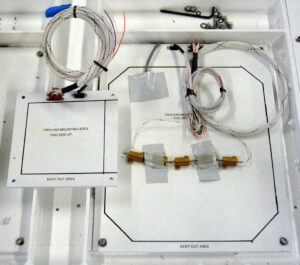HASP Participant Information
Call for Proposals
The HASP 2026 Call For Proposals has been released. As detailed in the CFP, the Friday, September 26, 2025, Teams conference information can be obtained by registering on the HASP 2026 Q&A Registration Form. If you intend to propose for a seat on HASP 2026, a Notice of Intent is required. The NOI is due on October 06, 2025. There is a new Cover Sheet and Proposal Template document for this HASP season. All applicants should follow this template guideline.
| HASP 2026 Call For Proposals | HASP 2026 CFP Document |
| HASP 2026 Q&A Registration | Form Link |
| HASP 2026 Notice of Intent | Form Link |
| HASP 2026 Coversheet and Proposal Template | HASP Coversheet and Proposal Template |
| Example HASP Student Payload Application | PDF Version |
| Example HASP Student Payload Application | PDF Version |
Teams preparing a HASP proposal/payload are advised to download and read the HASP Student Payload Interface Manual as well as CSBF website postings at https://www.csbf.nasa.gov/docs.html, particularly the FY07 User’s Handbook. Also of use are the Gondola Design documents at http://www.csbf.nasa.gov/gondoladocs.html.
Student Payload Interface
| HASP Payload Interface Manual | HASP Student Payload Interface Manual |
There are two classes of payload seats available to students on HASP. The more numerous “small payload class are generally used for smaller experiments or testing of satellite prototypes. The “large” payload class is useful for complex, large geometry, or heavy experiments. The detailed compatibility for each payload class is given below.
| Small Student Payloads: | |
| Total number of Positions available | up to 16 |
| Maximum Weight: | 3 kg (6.6 lbs) |
| Maximum Footprint (must include mounting structure): | 15 cm x 15 cm (approximately 6″x6″) |
| Maximum Height (may need to be negotiated with neighbor payloads): | 30 cm (approximately 12″) |
| Supplied Voltage: | 26-30 VDC |
| Available Current: | 0.5 Amps |
| Maximum serial downlink (bitstream): | 4800 bps |
| Serial interface: | 4800 baud, RS232 protocol, DB9 connector |
| Analog downlink: | 1 ADC Input 0 to 5 VDC |
| Discrete commands: | Power On, Power Off and 1 additional command |
| Analog & discrete interface | EDAC 516-020 |
| Large Student Payloads: | |
| Total number of Positions available | up to 8 |
| Maximum Weight: | 20 kg (44 lbs) |
| Maximum Footprint (must include mounting structure): | 38 cm x 30 cm (approximately15″x12″) |
| Maximum Height (may need to be negotiated with neighbor payloads): | 30 cm (approximately12″) |
| Supplied Voltage: | 26-30 VDC |
| Available Current: | 2.5 Amps |
| Maximum serial downlink (bitstream): | 4800 bps |
| Serial interface: | 4800 baud, RS232 protocol, DB9 connector |
| Analog downlink: | 1 ADC Input 0 to 5 VDC |
| Discrete commands: | Power On, Power Off and 1 additional command |
| (It may also be possible to negotiate up to 4 additional command pairs; i.e. F1 on, F1 off) | |
| Analog & discrete interface | EDAC 516-020 |
 Each student team accepted for flight on a HASP mission will be shipped either a “small” or “large” payload mounting plate (see figure). each plate is constructed of 6 mm thick PVC with a “keep out” area marked around the parameter and holes in each corner for bolting the plate to HASP. Within the allowed region of the plate the payload can be mounted and wired as necessary. Also provided on the plate are DB9 and EDAC 516 connectors with wiring pigtails to provide the telemetry, power & commanding interface. Details about the mounting plate and electrical interface can be found in the HASP Student Payload Interface Manual.
Each student team accepted for flight on a HASP mission will be shipped either a “small” or “large” payload mounting plate (see figure). each plate is constructed of 6 mm thick PVC with a “keep out” area marked around the parameter and holes in each corner for bolting the plate to HASP. Within the allowed region of the plate the payload can be mounted and wired as necessary. Also provided on the plate are DB9 and EDAC 516 connectors with wiring pigtails to provide the telemetry, power & commanding interface. Details about the mounting plate and electrical interface can be found in the HASP Student Payload Interface Manual.
